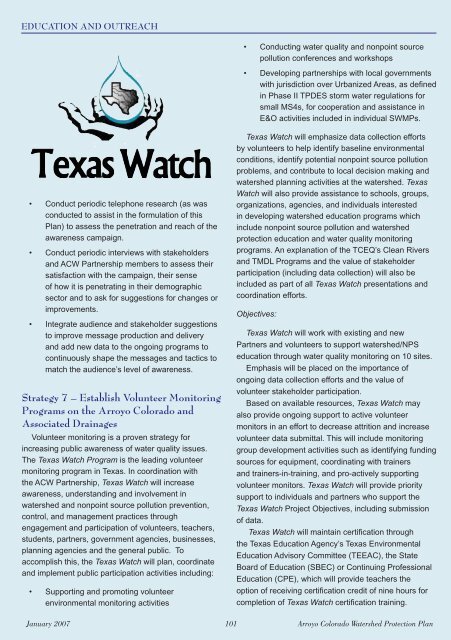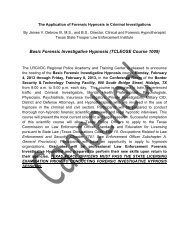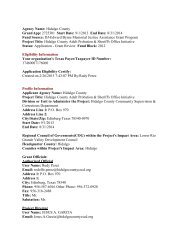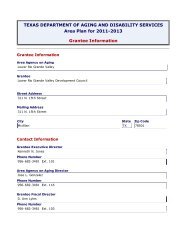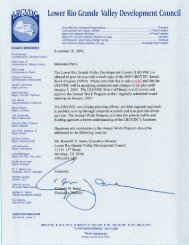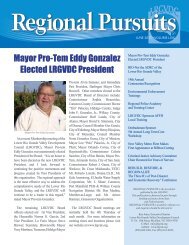Watershed Protection Plan - Lower Rio Grande Valley Development ...
Watershed Protection Plan - Lower Rio Grande Valley Development ...
Watershed Protection Plan - Lower Rio Grande Valley Development ...
You also want an ePaper? Increase the reach of your titles
YUMPU automatically turns print PDFs into web optimized ePapers that Google loves.
EDUCATION AND OUTREACH<br />
• Conducting water quality and nonpoint source<br />
pollution conferences and workshops<br />
• Developing partnerships with local governments<br />
with jurisdiction over Urbanized Areas, as defi ned<br />
in Phase II TPDES storm water regulations for<br />
small MS4s, for cooperation and assistance in<br />
E&O activities included in individual SWMPs.<br />
• Conduct periodic telephone research (as was<br />
conducted to assist in the formulation of this<br />
<strong>Plan</strong>) to assess the penetration and reach of the<br />
awareness campaign.<br />
• Conduct periodic interviews with stakeholders<br />
and ACW Partnership members to assess their<br />
satisfaction with the campaign, their sense<br />
of how it is penetrating in their demographic<br />
sector and to ask for suggestions for changes or<br />
improvements.<br />
• Integrate audience and stakeholder suggestions<br />
to improve message production and delivery<br />
and add new data to the ongoing programs to<br />
continuously shape the messages and tactics to<br />
match the audience’s level of awareness.<br />
Strategy 7 – Establish Volunteer Monitoring<br />
Programs on the Arroyo Colorado and<br />
Associated Drainages<br />
Volunteer monitoring is a proven strategy for<br />
increasing public awareness of water quality issues.<br />
The Texas Watch Program is the leading volunteer<br />
monitoring program in Texas. In coordination with<br />
the ACW Partnership, Texas Watch will increase<br />
awareness, understanding and involvement in<br />
watershed and nonpoint source pollution prevention,<br />
control, and management practices through<br />
engagement and participation of volunteers, teachers,<br />
students, partners, government agencies, businesses,<br />
planning agencies and the general public. To<br />
accomplish this, the Texas Watch will plan, coordinate<br />
and implement public participation activities including:<br />
• Supporting and promoting volunteer<br />
environmental monitoring activities<br />
Texas Watch will emphasize data collection efforts<br />
by volunteers to help identify baseline environmental<br />
conditions, identify potential nonpoint source pollution<br />
problems, and contribute to local decision making and<br />
watershed planning activities at the watershed. Texas<br />
Watch will also provide assistance to schools, groups,<br />
organizations, agencies, and individuals interested<br />
in developing watershed education programs which<br />
include nonpoint source pollution and watershed<br />
protection education and water quality monitoring<br />
programs. An explanation of the TCEQ’s Clean Rivers<br />
and TMDL Programs and the value of stakeholder<br />
participation (including data collection) will also be<br />
included as part of all Texas Watch presentations and<br />
coordination efforts.<br />
Objectives:<br />
Texas Watch will work with existing and new<br />
Partners and volunteers to support watershed/NPS<br />
education through water quality monitoring on 10 sites.<br />
Emphasis will be placed on the importance of<br />
ongoing data collection efforts and the value of<br />
volunteer stakeholder participation.<br />
Based on available resources, Texas Watch may<br />
also provide ongoing support to active volunteer<br />
monitors in an effort to decrease attrition and increase<br />
volunteer data submittal. This will include monitoring<br />
group development activities such as identifying funding<br />
sources for equipment, coordinating with trainers<br />
and trainers-in-training, and pro-actively supporting<br />
volunteer monitors. Texas Watch will provide priority<br />
support to individuals and partners who support the<br />
Texas Watch Project Objectives, including submission<br />
of data.<br />
Texas Watch will maintain certifi cation through<br />
the Texas Education Agency’s Texas Environmental<br />
Education Advisory Committee (TEEAC), the State<br />
Board of Education (SBEC) or Continuing Professional<br />
Education (CPE), which will provide teachers the<br />
option of receiving certifi cation credit of nine hours for<br />
completion of Texas Watch certifi cation training.<br />
January 2007 101 Arroyo Colorado <strong>Watershed</strong> <strong>Protection</strong> <strong>Plan</strong>


